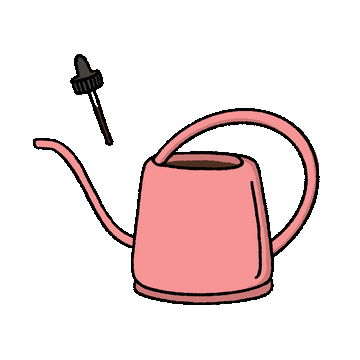Had enough? If you've gone plant mad and need to do a plant cleanse asap, well, this blog is for you. Alternatively if you're just looking for mistakes to avoid as you march forward on your jungle journey - well read on.
To be very clear - There is no shame in a houseplant death. It is not ideal, and I’m sure it is very rarely premeditated. Truth is these plants aren’t meant to be indoors. And no matter how much of a green thumb you have, or how many years you’ve spent studying horticulture or botany, or how many plantstagrams you follow…nothing compares to real, raw experience.
And that’s what a plant death is - it's an experience. For you, and definitely for your plant. The important thing is that you learn from it. What went wrong? Too much water? Not enough light? Maybe you just don’t like plants?
Once you figure this out, you can prevent yourself from making the same mistake again. But that's just one of many, many possible mistakes to make. And as a couple of plant-loving, occasionally-plant-killing, plant dad’s ourselves, we’d love to share some of our experiences with you to hopefully help keep more plants thriving.
Let’s start with a few essentials:
- Fertilizer. If you’re not on it already - this is the good stuff. Having a regular fertilizing routine with your houseplants is essential to any thriving indoor plant family. We’ve talked about how important this is here, here, and here.
- Potting Mix. Get those plants into a quality potting mix asap. None of that growers mix. And if you’re skeptical, read our blog on potting mix here.
- Check your plant placement. Is there enough light? Is it too close to a draft or heat source?
- Clean those leaves! Inside there is no wind or rain to remove dust from the foliage, so its up to you to help them photosynthesize by keeping the foliage clean and dust free. And if you’re wiping them anyway, then why not use some Neem Oil?
The Plant Runner’s Guide To a Successful Houseplant Murder.
An important reminder: your plants do not want to die. They’re usually pretty resilient and can survive - just not thrive - without much care at all. But if killing them is on the cards well below are some tried and tested methods.
1. Overwatering
You probably would have guessed this would be on the list. In oft-quoted but never-cited articles, ‘overwatering is the biggest killer of houseplants’. And while it would be near-impossible to prove overwatering really is #1 against plants, there is no disputes that it is a threat.
Overwatering occurs for a few reasons
- It could be that you’ve gone for a ‘one size fits all’ approach to watering, without looking into the different watering requirements for each plant.
- It might be that you’ve not adjusted for seasonal shifts, and as the temperature drops and the plants begin to take up less water, you’re still watering at peak summer levels.
- Then there is the classic, ‘I thought I was in charge of watering’ housemate debacle, where all plants get a double drink because your housemate or partner thought that was their job, but you know how irresponsible they are so you’d gone ahead and watered for them. Communication is key!
Signs of overwatering include:
- Leaf growth stops
- Leaves develop soft, rotten areas
- Leaves begin to drop
- The soil is soaked and not drying out
The Fix:
Well to start with, hold off on watering. We’d recommend repotting and checking for root rot, and then begin to establish a good routine like sticking your finger in the potting mix before watering just to make sure. Using a moisture meter is also a good option. Read a bit about your plant - they all have different needs and watering requirements, and the space you have them in will also impact how thirsty they are. Knowledge is power!
2. Not Enough Light
Just like overwatering, this isn’t uncommon. Just because a plant is sold as an ‘indoor’ or ‘house’ plant, does not mean that just by bringing it indoors it is going to thrive. That ficus might look incredible in your windowless bathroom, but that plant is on a fast train to plant heaven.
Signs your plant is not getting enough light:
- Smaller, stunted leaf growth
- Pale foliage
- Damp to wet potting media
- Leggy growth
The Fix:
Shuffle that guy! By the end of this post you’ll be reciting this in your sleep: Learn about your plant. Take some time to understand your plant’s light requirements and do your best to provide that. And if you’re dead-set on that fiddle-in-the-dark-bathroom vibe, then think about getting some grow lights.
3. Underwatering
I feel like underwatering is only such an issue because we’re all so scared of overwatering. And it's only more disappointing when you realize you’ve just killed your plant because you were being so vigilant about not overwatering it.
Or you’re just oblivious to your plant’s silent screams and hate routine.
But it is an easy one to avoid. Plants prefer a good, even drink. The idea that watering a little, often is incorrect and will only add another plant to the graveyard out back. Instead, waiting until the plant is ready for a drink (usually by checking to see if the top few centimeters of potting media are dry) and then giving it a real good, even drink (until water comes out the bottom of the pot) is best practice.
Signs your plant is being underwatered:
- Wilting foliage
- Dry, crumbling potting mix
- Leaf drop
The Fix:
- Start watering and water well! If the potting mix has dried out and is looking lifeless, think about adding some Soil & Microbe Booster in there to help increase water retention.
- Get a routine going to check on your plants. After a while you’ll just ‘know’ but initially, spending some time to check on the plant and touching the potting mix will do wonders for the health (and size) of your plant family.
4. Too Cold/Too Hot
Most houseplants are tropical plants. They come from places where the temperature doesn’t drop below 18°C and where they’ve never encountered frost. Best rule of thumb here is - if you are cold, your plants probably are too.
Signs your plants are cold:
- Curling leaves
- Browning foliage and leaf drop
- Yellowing leaves
- Stunted growth
- Black spots on foliage
But worrying about the cold doesn’t require you to chuck them next to a heater or open fireplace. Heat sources can cause just as much havok with indoor plants.
Signs your plants are too hot:
- Wilting leaves
- Dry, crispy leaves
- Leaf drop
- Sunburn
The Fix
- Be wary of rooms like bathrooms that are often heavily tiled and cold most of the day.
- Keep plants away from doors or windows that have drafts or are used frequently, especially over winter
- Pay attention to your aircon and heaters. Make sure your plants are not within 2m of a heat source and avoid them being in the direct line from the air conditioner.
5. Too much light
Too much of a good thing? It can be tricky providing your plant with the right amount of light. Dappled light, full sun, morning sun, indirect light….and then you’re expected to know how much time they need to spend in said light. We’ve discussed light levels here, so check it out if you want to get your head around the terms.
Signs your plant has received too much light:
- Leaf curl downwards
- Wilting
- Distorted growth
- Dry, brown marks on the foliage
The Fix:
This is pretty much the same fix as having too little light. Shuffle the plant, and investigate its requirements. Find a space that best provides its required light levels and leave it there. While it is always tempting to buy a new plant for a particular space, sometimes you need to make the space work for the plant instead.



Leave a comment